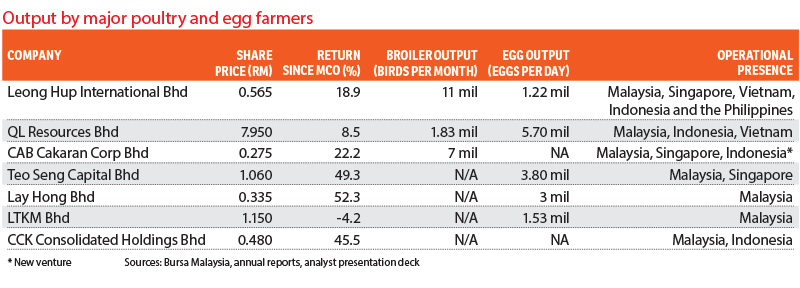
KUALA LUMPUR: Malaysia is among the top consumers of poultry meat worldwide. Data research house Statista has forecast that Malaysians would consume an estimated 49.4kg of poultry meat per person in 2020, almost 10 times more than the 5.42kg projected for beef and veal, the second-most preferred meat choice.
With the poultry farming industry clearly being an important industry in the country, the question is whether it is affected by the current movement control order (MCO) in the wake of the Covid-19 pandemic.
Integrated poultry producer CAB Cakaran Corp Bhd said its broiler chicken division has seen some impact from the MCO, as consumers are going for food that can last longer, especially frozen food.
At the same time, sales of fresh chickens have also been hit as a result of markets, hotels and restaurants — the main selling channels for fresh poultry — operating at minimal levels, CAB managing director Chuah Hoon Phong told The Edge Financial Daily in an email statement.
Chuah, however, shared that the group’s value-added food products division is currently running at full capacity.
“We see a spike in demand for our nuggets, sausages, burger patties and deli meats,” he said. “Value-added products usually command three to four times the margin of broiler products.”
CAB said it is working to ramp up its value-added products capacity by 50% to 1,500 million tonnes a month from the current 1,000 tonnes, to meet the demand.
Price holding firm
Meanwhile, based on ground checks, a poultry farm operator said that the price of fresh chickens in the central region of Peninsular Malaysia is holding up firmly, compared to last year’s dampening price trend.
Fresh chicken price is quoted daily, and the cyclical price nature is heavily influenced by the balance between supply and demand.
The farmer added: “The reason for the favourable price in the central region is self-explanatory — the stockpiling behaviour of consumers, and the higher population density in the Klang Valley.”
However, the farmer warned that if the MCO is prolonged, fresh poultry prices might be affected as chicken breeding is planned according to schedule and farmers without access to slaughtering and storage facilities may choose to sell at depressed prices.
On the question of disruption in farming activities, he said farming operations and the supply chain as a whole have not been interrupted by the MCO. However, to ensure smooth operations, biosecurity has been beefed up, especially prior to the loading of livestock.
Meanwhile, prospects for egg producers have been decent, with the product listed as one of the fastest-moving food items off supermarket shelves during the MCO. An egg farmer shared that eggs are in demand due to ease of storage and affordability.
The price of Grade C chicken egg has remained largely unchanged since November 2019 at 34 sen each. However, the surge in sales volume has been remarkable.
Survival of the fittest
Poultry and egg prices like other commodities are subject to their own cyclical patterns, which are highly dictated by the equilibrium between supply and demand.
As the industry’s entry barrier in terms of technological know-how is relatively low, the market is often susceptible to new entrants, causing supply and demand to lose balance in the short term, affecting the stability of prices.
However, factors such as scalability of operations and healthiness of cash flow are crucial for major players to better weather through volatility in prices, thus ensuring sustainability in the long run.
It is fair to say that survival of the fittest is distinguished in the industry, especially when less efficient farmers are eliminated from the market, which helps remove supply, and in turn putting upward pressure on the market price.
To better manage operational risks, it is common for big players to engage in contract farming services to pass on farming risks as the segment is most susceptible to various unpredictable factors, including disease outbreak that could wipe out the whole batch of chicken cultivation.
Another method to manage risks is for the farmer to set up vertical integration in production such as feed mill, incubation of day-old chicks, broiler breeding, slaughter and processing centres and distribution centres, in order to spread out risks across segments.
Listed companies that are predominantly involved in broiler breeding include CAB, Leong Hup International Bhd (LHI) and CCK Consolidated Holdings Bhd.
Meanwhile, QL Resources Bhd, Teo Seng Capital Bhd, Lay Hong Bhd and LTKM Bhd are largely involved in producing eggs.
In terms of production output, LHI is the leader among broiler production with 11 million birds per month, while QL Resources is the front runner for egg production with 5.7 million eggs a day.
Based on the Department of Statistics Malaysia figures, the supply of poultry and eggs in Malaysia has reached self-sufficient levels since 2018. It is not surprising for the major farmers to reach out to other countries in the region to further scale up on their operations. They include LHI, QL Resources, CAB, Teo Seng Capital and CCK Consolidated.
In terms of share prices, with the exception of Teo Seng Capital, most of the poultry farmers have portrayed a V-shape rebound, in line with the broad market optimistic sentiment.
In particular, shares in Lay Hong have rallied the most (up 52% or 11.5 sen to 33.5 sen last Friday), followed by Teo Seng Capital (up 49% or 35 sen to RM1.06) and CCK Consolidated (up 45% or 15 sen to 48 sen). Meanwhile, CAB is up five sen or 22% at 27.5 sen, while LHI has increased nine sen or 18.9% to 56.5 sen.
The more diversified QL Resources, meanwhile, has seen its share price rise 62 sen or 8.5% to RM7.95.
http://www.theedgemarkets.com/article/poultry-firms-count-nuggets-and-sausages-feed-sales-growth
